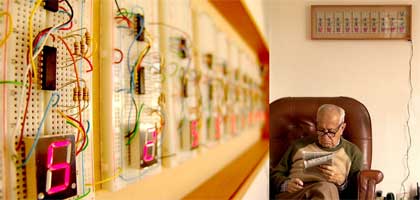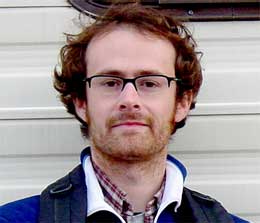 Alejandro Tamayo is an artist-engineer and a teacher working in the intersections of design, art and new technologies in a country that is often seen as the land of wild cartels, coffee, futbol, the terribly boring Fernando Botero (i’m quoting you here, Alejandro!): Colombia. I discovered his work by chance. He had emailed me to say that he wished i’d cover more of the Latin American art scene. That’s something i’d love to do but i wouldn’t know where to look for information about what’s going on up there (although i read Spanish). Then i realized that the best way to start was to ask a few questions to Alejandro about the lab he’s currently directing in Bogota.
Alejandro Tamayo is an artist-engineer and a teacher working in the intersections of design, art and new technologies in a country that is often seen as the land of wild cartels, coffee, futbol, the terribly boring Fernando Botero (i’m quoting you here, Alejandro!): Colombia. I discovered his work by chance. He had emailed me to say that he wished i’d cover more of the Latin American art scene. That’s something i’d love to do but i wouldn’t know where to look for information about what’s going on up there (although i read Spanish). Then i realized that the best way to start was to ask a few questions to Alejandro about the lab he’s currently directing in Bogota.
The v*i*d*a lab, part of the Aesthetics Department at the Javeriana University, is focusing on the development of new design products and ideas. Guided by a reflexion on life itself, the course proposes to engage with organic (biological) and “post-organic” (electronic, digital) visions, trying to identify new relationships and interrogations that could be translated into the realization of concrete projects.
I had a look at their website and blogs (old one, new one) and found their work amazingly good.
Just a few v*i*d*a lab projects i discovered and liked:
Prótesis para árboles en peligro (Prosthesis for endangered trees) takes into account a worrying fact: Bogotá is ranked among the most polluted (article in Spanish) cities in the word. This pollution is affecting not only its population of about 7 million people but also threatening the life span of the city’s tiny percentage of trees (0.25 trees/habitant, same as Brooklin!), especially those located along congested avenues.
 Prótesis para árboles en peligro, by students Juan Mojica, Alberto Sánchez, is a project that calls the attention of city dwellers by confronting them with a tree that waters and shakes itself in a desperate effort to get rid of the pollution that falls into its leaves (video 1 and 2).
Prótesis para árboles en peligro, by students Juan Mojica, Alberto Sánchez, is a project that calls the attention of city dwellers by confronting them with a tree that waters and shakes itself in a desperate effort to get rid of the pollution that falls into its leaves (video 1 and 2).
The system uses a 12v battery and a timing circuit that controls the two mentioned actions: the shaking of branches and the watering of the leaves. “For making the branches to shake themselves we hacked a second hand Xbox control and extracted its DC Motor with the excentric mass that creates the vibration,” explains Alejandro Tamayo. “For making the tree to water its leaves we used a 12 volts fish tank pump and a couple bottles of water.”
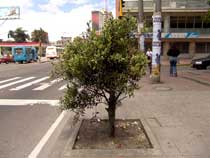
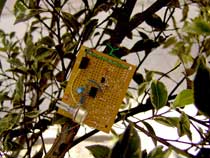 Prototype and prosthesis circuit
Prototype and prosthesis circuit
As part of the first Dorkbot Bogotá a working prototype was installed for a whole day in a tree located on Carrera Séptima, one of the most congested avenues of the city. The project is seeking support from the city in order to be fully implemented.
Other favorite projects:
Kit experimental de cocina (Experimental kit for Kitchen), by students: Adriana Cabrera, Iván Salazar, explores the questions: Can we hear the death of our meal while we prepare it? Can our kitchen ustensils obtain energy from them?
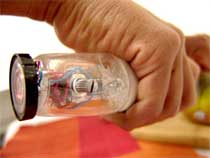
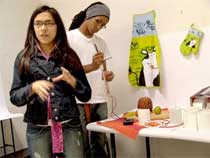
The kit is composed of a “sensitive� knife that screams (video) when cutting vegetables, fruits and other food; a set of containers each one with copper and zinc electrodes that can be plugged together to generate energy from different fruit juices; LEDS with different colors that can be easily connected to test the amount of energy obtained and a handbook with proposed experiments.
The Ducha para cantantes (Shower for singers), created by students Adriana Garcés and Jose Avila, is an interactive shower that reacts to tonal levels and voice frequencies. The louder you sing (up to a point) and the longer you do it, the more water you receive. When you stop singing for a while (this lapse of time can be selected by the user) the shower closes itself completely.
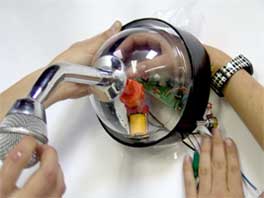
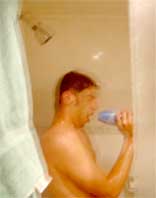
It is perfect for taking a shower with your love one and to start singing together under the water. The kit comes with a curtain that allows you to paste your favorites songs.
 Tamayo directed another course called Innovación Tecnológica y Cultura at Javeriana University. A blog with the students projects will soon be online. One of the proposed designs is the blender helmet that explores the possibility to have a kitchen but no electricity. “The idea is that without electric ustensils -and without the restriction of being plugged into the wall- we can develop alternative new relations and activities while preparing our meals, for example dancing,” Tamayo says. “While we dance we can be mixing our cocktails and drinks.”
Tamayo directed another course called Innovación Tecnológica y Cultura at Javeriana University. A blog with the students projects will soon be online. One of the proposed designs is the blender helmet that explores the possibility to have a kitchen but no electricity. “The idea is that without electric ustensils -and without the restriction of being plugged into the wall- we can develop alternative new relations and activities while preparing our meals, for example dancing,” Tamayo says. “While we dance we can be mixing our cocktails and drinks.”
For the record, Alejandro Tamayo is now also teaching a new course, Digital Media. MD belongs to the Faculty of Fine Arts at another university, the Jorge Tadeo University.
But let’s get back to V*I*D*A lab:
How did you come to create the V*I*D*A workshops and courses?
It all started about two and a half years ago when I was asked by the Aesthetics Department from Javeriana University to propose a new digital curriculum for design students. Back then I proposed a one and a half year program composed of three modules, having V*I*D*A at the end. Now each program is independent and none is a prerequisite to the other. The Beta version of V*I*D*A began in June 2005, and the corrected version in January 2006, however, it is an on-going process and I expect that we won’t ever have a final version.
I move by intuition, and I don’t know exactly where I’m driving the ship, but i try to maintain the general direction of the course: V*I*D*A emphasizes experimentation and reflection with physical and ubiquitous computing rather screen based works, while encouraging a critical, poetical and playful approach to technology.
Who are your students? What is their background? Do they have to be geeks and experts in electronics hacking to apply?
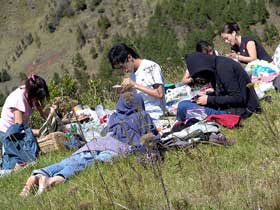 V*I*D*A is open in the 7th semester. Design students (and any other students from related disciplines who desire to choose it as an elective) can enter the program without having an idea of electronics or computing programming. From the first day we start playing with breadboards, sensors and electronic components, at the end of the 6 months program all students have acquired the basics to confidently build simple circuits and even to use and program a microcontroller.
V*I*D*A is open in the 7th semester. Design students (and any other students from related disciplines who desire to choose it as an elective) can enter the program without having an idea of electronics or computing programming. From the first day we start playing with breadboards, sensors and electronic components, at the end of the 6 months program all students have acquired the basics to confidently build simple circuits and even to use and program a microcontroller.
VIDA belongs to the department of aesthetics. Does it mean that there is some pressure to create some “beautifully designed” projects? Or do you think that a good design is part of the VIDA projects anyway?
I think the Department is more concerned with the philosophical aspects of the projects, the motivations behind them, and the questions they raise.
Your workshop on visible/invisible was, just like any of your courses, extremely playful. However there was also a critical approach to the subject (hidden, toxic electromagnetic fields and their impact on the human body for example). How optimistic are you about technology?
I’m rather optimistic in the short term, but quite suspicious in the long term, especially when I remember that our most common technologies, including the Internet, have been the result of military purposes.
We began our past program of V*I*D*A with two questions: the first one
What is life? (the usual question we pose at the beginning, and also at the end of the program) and the second one How to survive a nuclear disaster? This former question motivated students to reflect critically about technology and also inspired them to start developing ideas for possible contra-technologies.
And where are its dark sides?
Carl Sagan suggested that technological civilizations tended to destroy themselves rather quickly, and that perhaps, it has been in fact the case of many extraterrestrial civilizations.
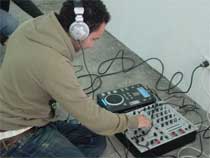
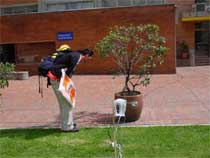 Recent course on Digital Media led by Alejandro Tamayo at Jorge Tadeo University
Recent course on Digital Media led by Alejandro Tamayo at Jorge Tadeo University
You like to make opposite meet: living/non-living; visible/invisible, toys/kitchen appliances. VIDA in particular engages with the living and the non-living. Can you tell us a few words about these concepts? How can they meet? What does an artistic approach bring to the research on living and non-living?
These questions sprang all kinds of bolts and nuts in my head. Here is my attempt for the least messy answers:
With the advances of science and technology, our traditional definitions and concepts are being put into question. What is life? What it means to be human? What it means for a machine to be alive? And eventually, where does the natural end and where does the artificial start? I like to confront students with these questions; and by the exploration of opposites (living/non-living for example) I encourage them to question the solidity of limits. Limits are fuzzy and intriguing, i think they offer a lot of opportunities from a design/artistic perspective.
In particular we are concerned with the shaping of everyday life but we find inspiration from scientific and technological developments, which usually take place in laboratories and specialized centers way detached from everyday life and not concerned with their cultural implications. In a certain way, VIDA is at the union of opposites and therefore encourages the blurring of solid categories and limits.
How can these opposite aspects meet?
From oriental religious philosophies like Hinduism, Taoism or Budhism we have learned that everything is in constant transformation, opposites meet eventually because they are complementary. Remember for example the Chinese symbol of Yin and Yang that represents the “two primal opposing but complementary forces found in all things in the universe�, part of yin is in yang and vice versa. Also, from Hindu mythology, the cosmic dance of Shiva represents the rhythmic process of life and death, the union of opposites.
Eventually everything is connected.
What does an artistic approach bring to the research on living and non-living (in comparison with scientific research)?
This is also a very good question. I believe artists can bring new research processes that are highly subjective and not constrained by predefined scientific goals. But also a critical distance, humor, and in general a cultural perspective that is essential in helping to close the gap between new scientific discoveries and technologies and the everyday life.
In one of the emails we exchanged you told me that the Columbian art scene has more to offer than Botero. Could you name us some Colombian artists who deserve to receive more attention from us?
I find the works of Maria Fernanda Cardozo (who lives in Australia), Elias Heim, José Alejandro Restrepo and Oscar Muñoz, to site just a few, particularly critical and inspiring, but there is also a growing number of younger artists doing very interesting things. In the conflux of art/design and digital technologies I’d rather site a few events and festivals that can give you a wider picture: Festival Internacional de la imagen in Manizales, El dÃa del Robot (a few words about it), Bogotrax and the coming Pixalazo and Selvatorium in June.
Something a bit unrelated before i forget. Who designed your websites? They are really beautiful.
Ha ha, Thank you! I do all the design work and most of the photographs.
Muchisimas gracias Alejandro.

